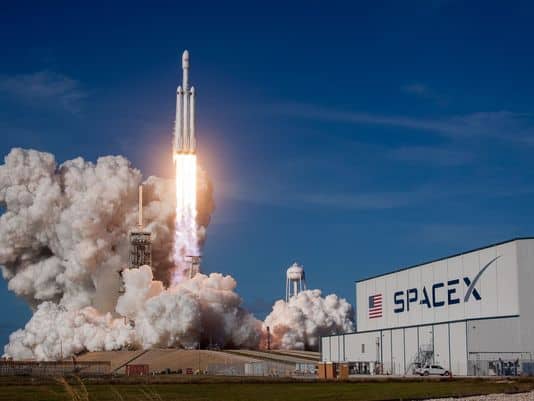
A pair of SpaceX satellites launching under the guise of a “secondary payload” on a Falcon 9 rocket from California this weekend may hold the keys to the company’s ambitious plans to enter the lucrative communications industry through an internet-beaming constellation.
Two small prototype spacecraft, labeled Microsat-2a and Microsat-2b, are scheduled to launch from Vandenberg Air Force Base at 9:17 a.m. Eastern time on Sunday, according to federal filings obtained by FLORIDA TODAY. If successful, the data they provide will help pave the way for SpaceX’s plans to launch nearly 12,000 satellites to low Earth orbit as soon as 2024.
That program, known as “Starlink” in documents filed last year, aims to beam high-speed internet connectivity back down to Earth from two separate orbits, bypassing the need for complicated on-the-ground infrastructure. Users would gain access to the network through small, laptop-sized terminals.
In a letter addressed to the Federal Communications Commission, SpaceX’s vice president of satellite government affairs, Patricia Cooper, confirmed that the two Microsats would hitch rides as payloads secondary to the company’s primary mission this weekend – launching PAZ, an Earth observation satellite, for Spain-based Hisdesat.
SpaceX would not discuss details about the Starlink satellites, but a previous filing with the FCC expanded on their physical characteristics and functions.
“These are experimental engineering verification vehicles that will enable the company to assess the satellite bus and related subsystems, as well as the space-based and ground-based phased array technologies,” the filing reads, further noting that Microsat-2a and -2b will target orbits about 700 miles above Earth during their six-month lifetimes.
Each satellite weighs about 880 pounds and, measuring at 3.6 feet by 2.3 feet by 2.3 feet, is about the size of a mini-fridge before solar panel deployment. The two 26-foot-long panels on each spacecraft will help power the flight computer; attitude and control; propulsion; a GPS receiver; and broadband, telemetry and command receivers and transmitters.
Both spacecraft are identical and will include cameras for video transmission of “key events,” according to the filing. Five test ground stations in the western United States will receive those signals at SpaceX headquarters in Hawthorne, California, as well as Fremont, California; McGregor, Texas; Brownsville, Texas; at SpaceX’s satellite development offices in Redmond, Washington; and at three moveable ground stations labeled “Broadband Test Vans 1-3” that will be near the fixed stations.
Trademark filings for Starlink last year also revealed that the constellation’s satellites will have the ability to conduct some remote sensing and Earth observation operations such as aerial surveying.
But why does CEO Elon Musk want to enter the communications industry? The general consensus among analysts is that he is looking to create a cash cow for the privately held company that its main industry – launch services – doesn’t provide. With tight margins and high risks, Musk’s long-term vision of Mars colonization likely cannot hinge on solely operating in rocketry.
According to the latest Satellite Industry Association report, the industry was valued at $260 billion in 2016, but at $5.5 billion, launch services were a fraction of that total. A 2017 Wall Street Journal report, though, concluded that the company expects to secure at least 40 million subscribers by the mid-2020s to the tune of more than $30 billion.
But Musk has an advantage: His company controls the ride to orbit. SpaceX could launch its constellation in a more direct manner compared to competitors who are also eyeing entries into the satellite broadband industry – namely OneWeb, which is building a satellite factory at Kennedy Space Center’s Exploration Park and has already fulfilled critical spectrum requirements with the FCC. The company’s first batch of satellites should launch this year on a Russian Soyuz rocket from French Guyana.
Other players include Boeing, Audacy, Karousel, LeoSat MA, O3b (owned by SES), Space Norway, Telesat Canada, Theia Holdings and ViaSat. Of those, only OneWeb, Space Norway and Telesat have gained access to the U.S. market through FCC approvals.
The hope appears to be that the constellation could propel Musk to similar financial standing as his rival, Amazon founder Jeff Bezos, whose rocketry company Blue Origin just completed its New Glenn rocket factory at KSC. Bezos boasted at a space convention in Colorado last year that his strategy for Blue Origin involves little more than selling billions dollars of his Amazon stock, which briefly made him the wealthiest person in the world.
But SpaceX and Musk received a surprise endorsement this week when FCC Chairman Ajit Pai circulated a proposal to fellow commissioners calling for approval of SpaceX’s constellation.
“Satellite technology can help reach Americans who live in rural or hard-to-serve places where fiber optic cables and cell towers do not reach,” he said in the proposal. “And it can offer more competition where terrestrial internet access is already available.”
“I have asked my colleagues to join me in supporting this application and moving to unleash the power of satellite constellations to provide high-speed Internet to rural Americans,” he said.
FCC support is critical to SpaceX’s – or any other organization’s – efforts to establish space-based internet services. Without it, the constellations cannot legally operate over the U.S.
On the mission front, meanwhile, teams at Cape Canaveral Air Force Station are targeting no earlier than 12:35 a.m. Feb. 25 for the launch of Hispasat 30W-6, a commercial communications satellite, for Spain-based Hispasat. A Falcon 9 rocket will boost it from Launch Complex 40 to a geostationary transfer orbit.
